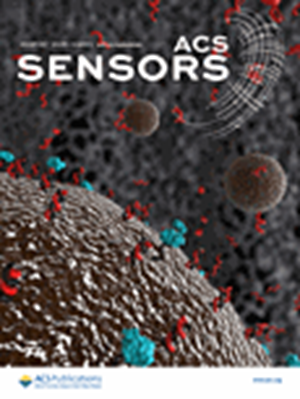带单向微流控室的可穿戴无线贴片用于汗液中无酶葡萄糖监测
IF 8.2
1区 化学
Q1 CHEMISTRY, ANALYTICAL
引用次数: 0
摘要
传统的基于生物酶的葡萄糖传感器在复杂的环境中容易受到干扰,特别是在可穿戴式汗液监测中。虽然合成纳米酶表现出更高的稳定性,但它们通常需要高碱性条件才能达到最佳性能,这限制了它们在可穿戴设备中的应用。为了解决这一挑战,本研究提出了一种新型的无酶可穿戴无线贴片,能够实时、原位监测汗液中的葡萄糖浓度。该设备采用微流控通道收集汗液,在其中溶解固体NaOH以创造所需的碱性环境。随后,汗液进入检测室,其中用金纳米粒子(Au-NPs/Ni-BDC NFs)修饰的二维镍基有机框架纳米花作为传感层,实现高灵敏度和稳定的葡萄糖检测。集成的温度和pH传感器提供实时校准,以确保测量精度,而特斯拉阀防止碱性溶液回流到皮肤。一款定制设计的智能手机应用程序通过管理信号采集、处理和无线通信,促进了身体活动期间汗液葡萄糖水平的实时分析。本研究通过在微流控通道内对汗液进行原位预处理,并与传感器阵列协同操作,有效克服了可穿戴设备无酶葡萄糖传感的关键挑战。该系统显示了未来健康监测的巨大潜力,特别是在运动和日常活动期间的实时跟踪。本文章由计算机程序翻译,如有差异,请以英文原文为准。

Wearable Wireless Patch with Unidirectional Microfluidic Chamber for Enzyme-Free Glucose Monitoring in Sweat
Conventional glucose sensors based on biological enzymes are prone to interference in complex environments, particularly for wearable sweat monitoring. Although synthetic nanozymes exhibit higher stability, they often require highly alkaline conditions to achieve optimal performance, limiting their application in wearable devices. To address this challenge, this study presents a novel enzyme-free wearable wireless patch capable of real time, in situ monitoring of glucose concentrations in sweat. The device employs a microfluidic channel to collect sweat, where solid NaOH is dissolved to create the required alkaline environment. Subsequently, the sweat enters a detection chamber, where two-dimensional nickel-based organic framework nanoflowers modified with gold nanoparticles (Au-NPs/Ni-BDC NFs) serve as the sensing layer, enabling highly sensitive and stable glucose detection. Integrated temperature and pH sensors provide real time calibration to ensure measurement accuracy, while a Tesla valve prevents the backflow of alkaline solution to the skin. A custom-designed smartphone application facilitates real-time analysis of sweat glucose levels during physical activity, by managing signal acquisition, processing, and wireless communication. Through in situ pretreatment of sweat within the microfluidic channel and cooperative operation with a sensor array, this study effectively overcomes key challenges in enzyme-free glucose sensing for wearable devices. The proposed system demonstrates significant potential for future health monitoring, particularly for real-time tracking during exercise and daily activities.
求助全文
通过发布文献求助,成功后即可免费获取论文全文。
去求助
来源期刊

ACS Sensors
Chemical Engineering-Bioengineering
CiteScore
14.50
自引率
3.40%
发文量
372
期刊介绍:
ACS Sensors is a peer-reviewed research journal that focuses on the dissemination of new and original knowledge in the field of sensor science, particularly those that selectively sense chemical or biological species or processes. The journal covers a broad range of topics, including but not limited to biosensors, chemical sensors, gas sensors, intracellular sensors, single molecule sensors, cell chips, and microfluidic devices. It aims to publish articles that address conceptual advances in sensing technology applicable to various types of analytes or application papers that report on the use of existing sensing concepts in new ways or for new analytes.
 求助内容:
求助内容: 应助结果提醒方式:
应助结果提醒方式:


